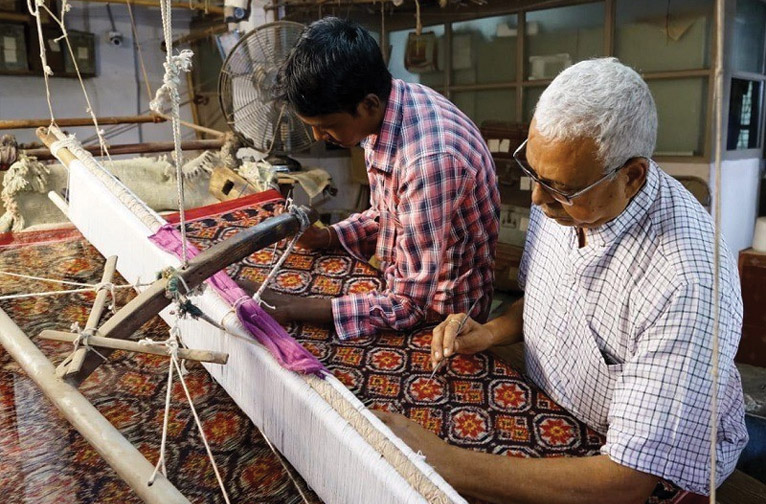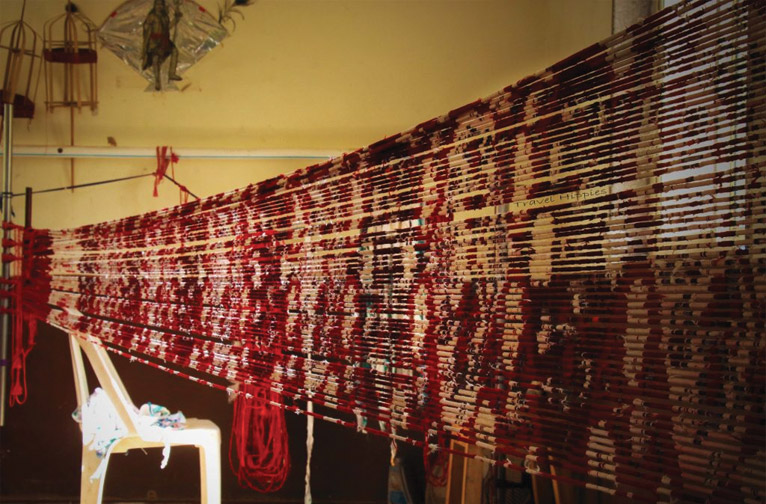With the Navaratri festivities keeping all of Gujarat all aglitter, it's an excellent opportunity to explore some of its most enduring textile traditions. The ancestral heritage weaves and prints of its beauteous Patola and Ajrakh fabrics is something you will surely love to add to your wardrobe back home.
Enduring Beauty of Ajrakh
The tradition of Ajrakh prints is something Gujarat shares with the neighbouring state of Rajasthan. The Muslim Khatri block printing artisans who brought this tradition to Gujarat Kutch region are believed to have migrated from the Sindh region, which is now part of Pakistan.
Tradition has it that the art of Ajrakh printing, which took birth in Sindh in proximity to the River Indus, dates back to 3000 BC. The riverside site was ideal for both the growing of indigo, which gives Ajrakh its iconic blue, and the multiple washing involved in the production process. The ruler of Kutch Rao Bharmalji (1586-1631), is said to have encouraged the Sindhi artisans to settle in Kutch to meet the burgeoning requirements of the court and the local populace.
The River Saran served as an excellent source of saline water and alum both critical for the dyeing process and also for different stages of washing and dyeing cloth. The original settlers established their base in Dhamadka. It was not just the royal court which benefited from their textiles, even the local nomadic people like the Rabaris and Maldharis started giving the artisans custom, especially as the treated fabric on which these beautiful patterns were printed was really durable.
What distinguishes Ajrakh from other block printing textile traditions like ikat, batik and the Sanganer ‘calico printing’ and Bagru’s direct dye (typically indigo) printing and mud-resist dye printing, prints is that indigo blue, or its variant is the principle base colour. It also stands apart for its natural red and black, with the white cloth resisted against a dark indigo blue background. A resist of lime coupled with gum is applied to define the outline of the design. Symmetrical patterns are printed carefully with the wooden blocks by hand on treated cotton fabric.
The colours that are used in this form of printing are also plant and mineral -based and the wooden blocks used to print the patterns are hand carved.
The painstaking Ajrakh printing technique involves anything between 14-16 stages of resist printing and resist dyeing. When the print appears on both sides, it is called Bipuri. If the printing is reserved to only one side of the cloth it is called Ekpuri.
The use of the colours also involves meticulous calculations with regard to the proportions used for dyeing of each hue. After each colour of print, the karigar will wash and dry the cloth in the sun.
Natural dyes include Indigo from the indigo plant for the blue that you see in Ajrakh prints; madder root provides the reds; Pomegranate Rind gives the yellow and green hues; the black dye is achieved from mixing rusty iron (Ferrous Sulphate) with tamarind seed powder; alizarin is another source for red dye; other shades of yellow are derived from turmeric.
Mordants and fixatives to hold the dye on the fabric include Harad (Myrobalan) and Alum
Nature serves as the primary inspiration for the choice of motifs that go into Ajrakh designs. As per Islamic design traditions the Khatri bloc printing community does not incorporate human or animal motifs in the Ajrakh. Champakali, Raiya, Kharek, Nipad, Grinari are amongst the most favoured designs. Other variations include Amlaliya, Jalebiya and the famous Kakkar pattern. Ajrakh printing also comes in the form of Matani Pachedi. Ahmedabad’s Saudagiri prints and the Batik prints from Bhuj also fall under the category of Ajrakh printing.
While sarees are the most popular form of Ajrakh designs there has been a spurt in Ajrakh printed soft furnishings etc.
An earthquake was the primary cause of the to leave the Kutchi village of Dhamadka in ruins; it was renowned for its ajrakh production from earliest times. International funding helped replicate the village, known as Ajrakhpur, about 12kms away from Bhuj. The relocated 100-odd artisan families swiftly took charge of the responsibilities of reestablishing the production in their new home which was very soon bustling with industrious endeavour again. During the Covid pandemic lockdown they also sought to experiment with new patterns and motifs and explore the quality of more natural dyes. The Geographical Indication (GI) certificate has been bestowed on traditional 'Kutch Ajrakh’.
A Passion for Patan Patola
The loss of Maharashtra and Karnataka was neighbouring Gujarat’s gain, when in the 12th century their traditional ikat artisans, the Salvi community, migrated en masse (there were 700 of them!) to Patan.
Founded by Vanraj Chavda in 746 CE Patan lies 130 km from Ahmedabad on the banks of the River Saraswati. It served as Gujarat’s First City from 746 CE to 1411 CE.
What propelled this unprecedented exodus of the community to Patan was the growing popularity of the fabric under Gujarat’s Rajput Solanki Dynasty. It is believed that Raja Kumarpala, adored it so much he would wear a fresh patola (specially sourced from South India for him) every day when visiting the temple to perform special rituals. His rule, from 1143-1173 CE, was considered the peak of the golden age of the Solanki period. Deeply offended that the artisans of Jalna in Maharashtra were using this precious design for bed covers Kumarpala invaded and annexed Jalna and brought the Salvi artisans to Patan to ply their skills under his watch.
The Salvi community holds its artisanal heritage as a sacred trust and is passed on from generation to generation of male members only, within the community itself. Today, this double ikat tradition of creating the design by tying and dyeing directly on the thread is being practiced by a few families and their extended members.
Patola is the name given to the double ikat silk from Patan, Gujarat. What also makes the Patan Patola so unique is that in this ikat variant both the warp and weft are first tied, then resist dyed with incredible precision to retain the dyed design on the field of the saree as well as on the motifs without seeping our blurring. As described in a note, on the indigenous Patan Patola double ikat, in the private Patan Patola Heritage Museum established by the Salvi family, this is the mother of all ikat techniques.


Patola sarees are also deeply intertwined with Gujarat cultural mores. It’s considered highly auspicious to be draped in one for a religious or important social occasion as it deflects the evil eye and brings good to the family, as well as the community at large. They are also held in high regard as precious gifts amongst royalty and the priestly class. Lotus flowers, leaves, and buds symbolise fertility and have an important place in patola sarees which are bestowed on daughters and daughters-in-law when they get married.
Given the highly labour-intensive, skill and precision— and time involved in their making, the highly expensive, intricately designed double ikat pure silk sarees, and kurta-pyjamas sets, are treasured as heirloom pieces. Patola sarees are even more special for their durability as each one can survive for about 300 years and even maintain the colours.
At the heart of Gujarat’s double ikat patola textile traditions is the bustling village of Patan. The ikat or resist dyeing generally, “involves the sequence of tying and dyeing sections of bundled yarn to a predetermined color scheme prior to weaving. Thus, this dye penetrates into the exposed sections, while the tied sections of the yarn remain un-dyed. The patterns on the yarn get expressed in the woven fabric”. (Ota, 2002)
Traditionally, patola sarees were woven in a 5-to-9-yard length and 45-to-54-inch width, in pure silk and natural dyes. A minimum of 500-600 g of silk is required to make one patola saree. The weaving of the fabric is still carried out on primitive hand-operated harness looms. This slanting loom is the only loom in the world that which has the ability to be inclined and declined. It takes 2-4 workers to complete a single piece.
Single ikat process is in which either warp or weft yarns are tied and dyed, the combined ikat is when warp and weft Ikat may coexist in different parts of the fabric; in Double ikat (in which the design looks exactly alike on both the sides) both warp and weft threads are tied with such precision that when woven, threads from both axes mesh exactly at certain points to form a complete motif or pattern.
The double ikat technique involves both the warp and weft threads being resist-dyed before the beginning of the weaving technique. Patan patola is a double ikat weaving technique, while Rajkot patola uses the less complicated single ikat weaving technique.
Originally the motifs or bhats that were most commonly used included nature-inspired themes including florals, foliage, parrots and elephants. Human figures and geometrics too found a place in the patolas.
When choosing your patola silk saree you should do your homework on what’s what when it comes to choosing a design of your choice. For example, if you are deep into nature-inspired patterns go for the Pan Bhat design which features motifs of pan-shaped leaves, parrots, flowers in bloom, elephants, and figures of female dancers; floral and elephant motifs dominate the Nari Kunjar Bhat design; Fulvali Bhat design also features floral designs. If it's geometrics that you love, go for the Rattanchowk Bhat design or Navratna Bhat design predominantly featuring square-shaped patterns.
Natural dyes like catechu, cochineal, indigo, turmeric, madder roots, manjistha, ratnajyot, katha, kesudo, natural lakh, harde, pomegranate skin, henna and marigold, give deeper heft to the beauty of each design.
Sadly, today the many variants of patola sarees, though cheaper, are created by using chemical dyes, and the quality deteriorates.
It can take anything from six months to a year to create a single double ikat Patola saree, depending on the intricacies of the pattern. A mega project involved the production of nine pieces of Shikaar (hunt) Bhat, which took over three and a half years in the making for a government event!
The Patan Patola Heritage Museum, set up by the Salvi community in 2014, is an attempt to preserve this incredible tradition which goes back over 750 years in Patan. It is only in recent years that the community has reluctantly started sharing this ancestral tradition with a few select artisans outside the community so it does not become extinct.
You can watch artisans carry on this complex and painstaking ancestral craft, which involves tying, weaving and dyeing, to produce the most exquisite handcrafted silk ikat sarees for which Gujarat is now world renowned.